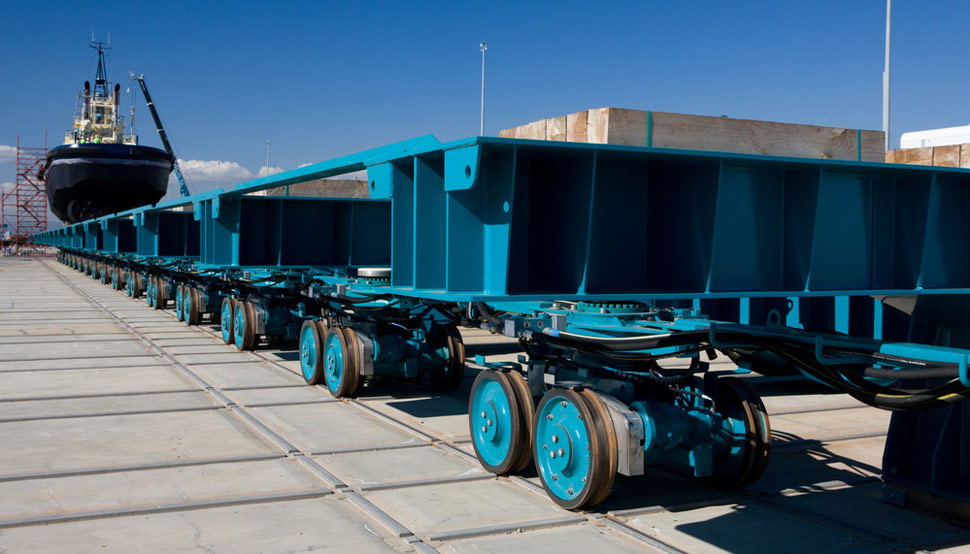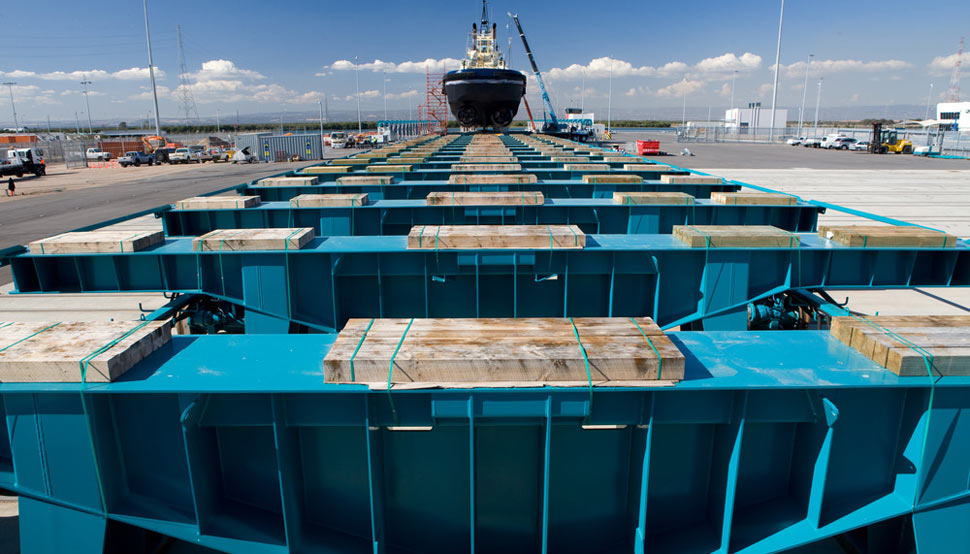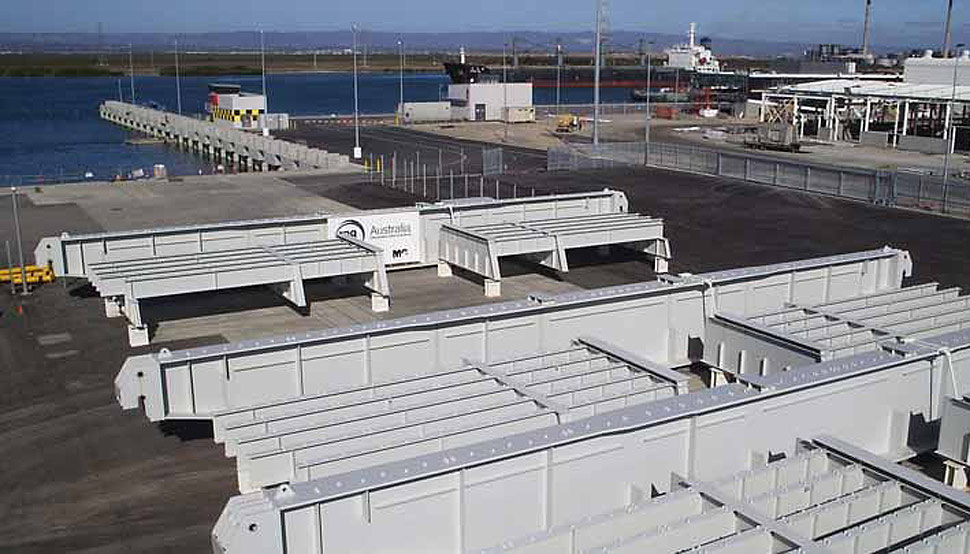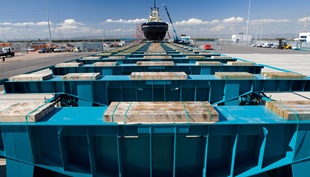Australian steel reinforcing Australia's defence capability
Leading Australian steel fabricator, RPG Australia, completed the fabrication, construction and installation of a shiplift at Techport Australia using 2,800 tonnes of XLERPLATE® steel.
Credentials:
Location: Osborne, South AustraliaClient: Rolls Royce Australia Services Pty Ltd
Fabricator: RPG Australia
Project Size: 2800 tonnes of XLERPLATE® steel
Design: TTS handling systems
Fabricator: RPG Australia
Defence SA Shiplift
Leading Australian steel fabricator, RPG Australia, recently completed the fabrication, construction and installation of a shiplift at Techport Australia using 2,800 tonnes of XLERPLATE® steel. The shiplift is located within the Common User Facility (CUF) at Osborne in South Australia. It will be used to support commercial and defence shipbuilding and maintenance activities, including the construction and ongoing maintenance of the new Air Warfare Destroyers, a key element of Australia's national maritime security capabilities.
It has been, according to RPG's Contract Manager Peter Hall, "An extremely interesting project with many diverse and complex elements involved. These include plate profi ling, machining, painting, assembly, hydraulics and operational and load testing of the equipment. All manufacture and installation activities were undertaken by RPG, with the assistance of capable and approved sub-contractors."
The shiplift, as its name implies, is a mechanism that lifts ships (or submarines) out of the water for maintenance, repair and construction operations.
Multiple Companies and Strong Relationships
The project was comprised of the complete design and construction of three key elements: a working platform, 40 'off' hoists to lift the platform and a transfer system to allow the ships to be moved on and off the platform, all designed and manufactured to the requirements of Lloyds Register. Lloyds is a third party inspection company which provides independent verifi cation that the material is suitable for the standard to which it is made. RPG manufactured and installed the fi rst two elements under a sub-contract with Rolls Royce Australia Services Pty Ltd and the third element under a separate sub-contract with the Norwegian company TTS. The ultimate client for the whole project was Defence SA.
South Australia prides itself on being able to deliver some of the Royal Australian Navy's largest projects through the nation's premier naval industry hub, Techport Australia.
"The project commenced with an enquiry and order for the main element - the platform," said Peter. "During the fabrication of this order, we were also successful in securing contracts to provide the shiplift's 40 off hoists and then the complete transfer system, culminating in the site installation, load testing and setting to work of the entire system.
"RPG built the system after transporting all the manufactured key structural elements to the CUF site. We then assembled and welded these together to form completed platform modules (19 in total). This fi nal consolidation had to be carried out onsite due to their physical size.
"There is very little of the mechanical aspect of the whole shiplift project RPG has not manufactured. It is rare for a fabricator to be commissioned to undertake all elements of a project: from manufacturing, to installation, to testing and fi nal handover. As a result, this project has been a really satisfying experience for the whole team."
Rolls Royce Australia Services Pty Ltd was RPG's direct client for the entire scope of the supply and manufacture of the platform and hoists, as well as the onsite installation utilising Rolls Royce Naval Marine Inc. - based out of Annapolis, USA - for the technical design of the shiplift system. Rolls Royce is a global business providing integrated power systems for use on land, at sea and in the air.
TTS handling systems designed the transfer system and were RPG's direct client for the manufacture of the trestles and trolleys which make up the transfer system. TTS is a global enterprise that designs, develops and supplies equipment for the marine, oil and gas industries.
Project Components and How They Work
The platform, along with its positioned trestles, is lowered up to 18 metres into the water by the 40 hoists. The platform maintains its level through the control systems that synchronise all the hoists. The ship is then accurately positioned above the trestles and secured to the bollards and winches on the surrounding civil works. The platform is then raised along with the ship, which is supported entirely by the trestles. The transfer system is comprised of 42 hydraulically operated trolleys, 21 trestles and a power/control vehicle. The system, when coupled with all trestles/trolleys (in the desired position to suit the required lift), drives onto the platform. The trolleys lift all the trestles at the same time and place them on the platform. Following this:
- the trolleys are then driven off the platform
- the platform and trestles are lowered
- the ship is docked and secured on the trestles
- the platform is then raised and the trolleys returned to trestles, where the ship is supported before it is lifted clear of the platform.
The trolleys/trestles/ship are then driven off the platform to the 'hard stand'. This driving takes place on rail tracks preset into the concrete hard stand. The ship is moved to its chosen 'parking spot' and then the trolleys lower the trestles and the ship is parked, allowing the trolleys and platform to be used for further incoming/outgoing ships.
The advantage of using this equipment, and applying this methodology, is that once one ship is moved into an appropriate position on the dry berths concrete hard stand area, the trolleys can lower the trestles with the ship on top allowing the trolleys to be removed and relocated to pick up another ship.
This is in contrast to working on ships in a typical dry dock scenario. Using the platform, hoists and transfer system that RPG has manufactured and installed, allows multiple vessels to be worked on at once. This has the potential to save time and money, whilst also facilitating the servicing of Australia's defence capability.
How XLERPLATE® steel Was Used
Of the 2,800 tonnes of 350 Grade XLERPLATE® steel used, 1,600 tonnes were used on the platform, 700 tonnes were used on the hoists and 500 tonnes were used on the transfer system.
Some Bisplate 80 low alloy steel was also used on the project. This grade is manufactured by Bisalloy Steels using a 'quench and tempered' heat treatment. Bisalloy Steels use BlueScope Steel as a feed material supplier for this process. This grade is very high strength due to the combination of low alloy content and heat treatment, but it also has good toughness and weldability. XLERPLATE® steel was used in the main transverse beams (20 of them) of the shiplift platform structure; the 40 bedplates (frame) and 40 drums of the hoists; and the 21 trestles and 42 trolleys on the transfer system. Plate profi ling, welding, painting and assembly were the main processes applied to the XLERPLATE® steel. Unique elements of the fabrication included the:
- main traverse beams, each being 38 metres in length and weighing 80 tonnes, being turned in specially designed rotators to allow positional welding
- heavy beam members of the hoists being manufactured and placed in rotators to weld out the longitudinal welds.
"One of the engineering challenges of the job included maintaining the tolerances of large fabrications manufactured in module packages in the workshop environment," explained Peter.
"Transporting these large modules, then setting up and welding them out onsite, within tolerances required for completed modules weighing up to 300 tonnes each, was also challenging. Specialised transport equipment was designed and manufactured to convey the fabricated steel to the dock.
"Grade 350 plate was the material grade stipulated on the drawings and specifi cations for manufacture," continued Peter. "We elected to purchase XLERPLATE® steel in preference to imported plate as we prefer to purchase locally when the price and delivery requirements suit our needs. It is also more convenient."
RPG submitted a schedule nominating when XLERPLATE® steel was required. "BlueScope supplied on time to our requirements and the manufacture schedule was maintained."









